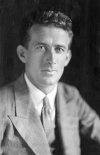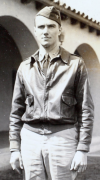-
When you click on links to various merchants on this site and make a purchase, this can result in this site earning a commission. Affiliate programs and affiliations include, but are not limited to, the eBay Partner Network.
You are using an out of date browser. It may not display this or other websites correctly.
You should upgrade or use an alternative browser.
You should upgrade or use an alternative browser.
Buttoned Pocket Flaps A-2 Jackets
- Thread starter 33-1729
- Start date
zoomer
Well-Known Member
Where's the full pic? Maybe I can image search it and get something bigger.Here is another photo. An enlarged detail from a 1933 photo.
Look at the epaulettes of the standing man with light coloured cuffs.
getting to recognize these guys now...Chas. Howard top l, my fellow Iowan Hugh Knerr next to him with the mystery collar, Ira Eaker bottom l and Harold McClelland (another Iowan!) bottom right. I could swear that was CAC Gen. Fechet top center in the dress cap, but he retired at the end of 1931. (Edit: it's probably Maj. Barney Oldfield, who attended the avigation unit, altho I have few pix of him.)
Last edited:
Ken at Aero Leather
Well-Known Member
Jay
#4 is wearing it very open .........Saturday Night Fever?
Makes the collar look much bigger than it probably is
#4 is wearing it very open .........Saturday Night Fever?
Makes the collar look much bigger than it probably is
zoomer
Well-Known Member
Just one quibble gents...but to my mind a fairly substantial one.
Why authorize something as standard issue, and then only order 25 of them, from only one supplier?
Planes were that kind of expensive - thus the "Y" service test batches of half a dozen or a dozen, plus one for static tests. But jackets were relatively cheap.
To be clear, I'm arguing that Spatz's no-epps A-2 was a "YA-2," ie, service test - and that that's what the Goldsmith order was and why it was so very small.
Roughwear has come to say no, what Spatz has is an "XA-2," ie, a prototype - and that Arnold's A-2, with epps and tab collar but w/o snaps, is the Goldsmith "YA-2" due to extra pocket stitching and the unique collar/stand.
Max Werber was known for labor- and money-saving touches (he patented a pieced panel leather jacket in 1929). Assuming he made the Arnold jacket (ie, that it is 32-6225), he might have costed it out after the fact and figured to save x¢ per unit-hour by single-stitching the pockets and substituting snaps for buttons/holes on 33-1729. Any little bit saved would have been welcome to the Army and certainly to Werber Coat. They had a good relationship in the 30s, so Werber must have given particularly good quality for the money.
Possible quibbles with my scenario:
- Security 32-485 was first with snaps, but only on the collar points. Why would the later Werber 32-6225 not use them? Pilots can't have preferred buttons - unless they distrusted snap fasteners. Or maybe snaps got a lot cheaper during FY '32 - lots of things did!
- Adding epaulets is a bigger change than any collar/snap/stitch. Would a military article change so significantly between spec drawing and full production?
Drawing No. 30-1415 will reveal much. It must be found!!!
Why authorize something as standard issue, and then only order 25 of them, from only one supplier?
Planes were that kind of expensive - thus the "Y" service test batches of half a dozen or a dozen, plus one for static tests. But jackets were relatively cheap.
To be clear, I'm arguing that Spatz's no-epps A-2 was a "YA-2," ie, service test - and that that's what the Goldsmith order was and why it was so very small.
Roughwear has come to say no, what Spatz has is an "XA-2," ie, a prototype - and that Arnold's A-2, with epps and tab collar but w/o snaps, is the Goldsmith "YA-2" due to extra pocket stitching and the unique collar/stand.
Max Werber was known for labor- and money-saving touches (he patented a pieced panel leather jacket in 1929). Assuming he made the Arnold jacket (ie, that it is 32-6225), he might have costed it out after the fact and figured to save x¢ per unit-hour by single-stitching the pockets and substituting snaps for buttons/holes on 33-1729. Any little bit saved would have been welcome to the Army and certainly to Werber Coat. They had a good relationship in the 30s, so Werber must have given particularly good quality for the money.
Possible quibbles with my scenario:
- Security 32-485 was first with snaps, but only on the collar points. Why would the later Werber 32-6225 not use them? Pilots can't have preferred buttons - unless they distrusted snap fasteners. Or maybe snaps got a lot cheaper during FY '32 - lots of things did!
- Adding epaulets is a bigger change than any collar/snap/stitch. Would a military article change so significantly between spec drawing and full production?
Drawing No. 30-1415 will reveal much. It must be found!!!
Last edited:
Ken at Aero Leather
Well-Known Member
It would be a huge help if we knew who the crew/unit were in the 1933 picture, top brass or regular Joes? Re post #124
2BM2K
Well-Known Member
Here is a link to the original photo.
https://www.flickr.com/photos/sdasmarchives/11735622345/in/album-72157639362216823/
This is on Flickr, part of the SDASM collection
https://www.flickr.com/photos/sdasmarchives/11735622345/in/album-72157639362216823/
This is on Flickr, part of the SDASM collection
zoomer
Well-Known Member
This was the(?) Advanced Aviation Training Unit (edit: "Avigation" - see just below), ie, hot pilots and those who showed promise to be same. Can't find much reference to it tho.It would be a huge help if we knew who the crew/unit were in the 1933 picture, top brass or regular Joes? Re post #124
A lot of the AAC's most experienced pilots then were age 40 or better but still low ranking. They had been WW1 or prewar vets - often ground army - who had learned to fly. Some had left the service or been temporarily promoted, then reduced. Promotion was very slow interwar of course.
Let's see, of the 4 I recognize, Howard in 1933 was 41 and either a 1st looie or captain - Knerr, 46, a major - Eaker, 37, a temp major - McClelland, 39, a captain. 3 of them were on the Alaska flight a year later. Maybe others here were; I suspect so. It was a small world in the Air Corps then.
Unfortunately this pic is not likely to get any bigger or sharper. It's out of a scrapbook kept by a lieutenant at March Field and there is no match for it on Google Images.
Last edited:
zoomer
Well-Known Member
Ah yes thanks. (No wonder that term never caught on.)
The date 1933 (edit: comes from Lt. Goetz' graduation certificate - see below.)
The civilian in the light suit is Harold Gatty, "Prince of Navigators," who mapped for the Lindberghs, flew with Post, and was engaged to instruct at the AATU.

Source of the pic was Lt. Robert Goetz. He was navigator on an amphibian flight from Rockwell to intercept an Army transport ship 130 mi at sea in May, 1934 (per Air Corps News Letter Jan. 15, 1935). This "routine navigation problem" was accomplished by dead reckoning in poor visibility conditions. Capt. W.T. Larson was pilot and is 3d from right front in the 1933 class photo. I have not spotted Goetz yet - (edit: he isn’t in it - prob b/c he was busy taking it!) - but here he is.
 click to enlarge
click to enlarge
2Lt. Robert W. Goetz Collection at Flickr
The date 1933 (edit: comes from Lt. Goetz' graduation certificate - see below.)
The civilian in the light suit is Harold Gatty, "Prince of Navigators," who mapped for the Lindberghs, flew with Post, and was engaged to instruct at the AATU.

Source of the pic was Lt. Robert Goetz. He was navigator on an amphibian flight from Rockwell to intercept an Army transport ship 130 mi at sea in May, 1934 (per Air Corps News Letter Jan. 15, 1935). This "routine navigation problem" was accomplished by dead reckoning in poor visibility conditions. Capt. W.T. Larson was pilot and is 3d from right front in the 1933 class photo. I have not spotted Goetz yet - (edit: he isn’t in it - prob b/c he was busy taking it!) - but here he is.
 click to enlarge
click to enlarge2Lt. Robert W. Goetz Collection at Flickr
Last edited:
zoomer
Well-Known Member
It's in just the right place for one!
Yes indeed. These Goldsmith jackets may have been made for more senior officers to evaluate following earlier evaluations with those jackets without epaulets. Once they were completed larger orders were placed with Security and Werber.
Arnold would have had easy access to the test jackets for in 1930 he became Chief of the Field Service Section, Air Corps Materiel Division.
Of course the Goldsmith jackets may not have been test jackets at all, but just a small initial order as Goldsmith did not have the capacity to fulfil a larger one. Why the government did not place their first A-2 order with Werber or Security is an interesting question.
Arnold would have had easy access to the test jackets for in 1930 he became Chief of the Field Service Section, Air Corps Materiel Division.
Of course the Goldsmith jackets may not have been test jackets at all, but just a small initial order as Goldsmith did not have the capacity to fulfil a larger one. Why the government did not place their first A-2 order with Werber or Security is an interesting question.
Last edited:
Silver Surfer
Well-Known Member
this has become a positively fascinating thread. many thanx to all of you guys that are digging up the pix and info. so, the question at hand becomes, who is going to make a goldsmith repro? yeah, i know, there are not jackets available to handle, measure,, examine, only speculation. never the less......
Skyhawk
Well-Known Member
I have been planning a P Goldsmith & Sons A-2 for about a year. It fits in perfectly to my focus of jackets at Headwind to reproduce jackets from the golden age of flight, the 1920's - 1940's. Details have been sketchy but I have made progress over the past year with my research on this first Type A-2 jacket.
I already have the labels designed.
This new jacket post brings more details to the jacket and paints a more clear picture. I feel that this new information, combined with my research, now make it possible to make a great reproduction of this jacket.
Stand By......
- Jay
I already have the labels designed.
This new jacket post brings more details to the jacket and paints a more clear picture. I feel that this new information, combined with my research, now make it possible to make a great reproduction of this jacket.
Stand By......
- Jay
Silver Surfer
Well-Known Member
hot damn, jay. gofret
Staff online
-
mulceberModerator
Latest posts
-
What jacket(s) are you wearing at the moment?
- Latest: Wholenineyards
-
-
-
-
